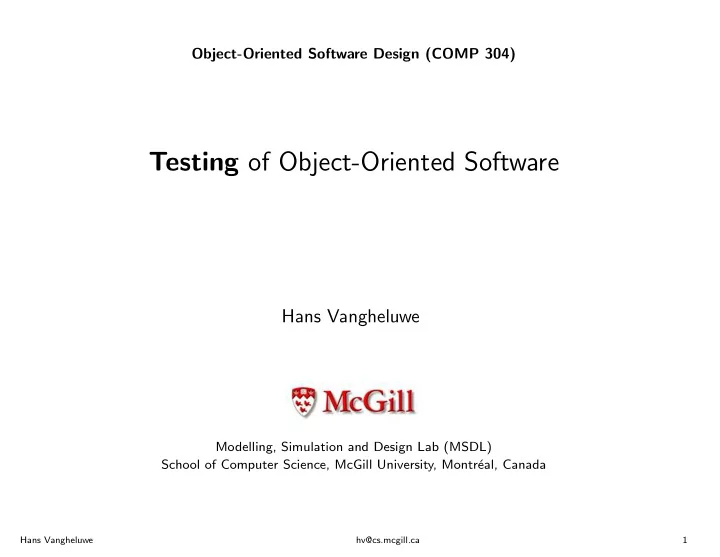

Object-Oriented Software Design (COMP 304) Testing of Object-Oriented Software Hans Vangheluwe Modelling, Simulation and Design Lab (MSDL) School of Computer Science, McGill University, Montr´ eal, Canada Hans Vangheluwe hv@cs.mcgill.ca 1
Overview 1. Testing background • Testing as part of the Software Process • Terminology • Types of Testing 2. Test-Driven development: Unit Testing • Test for Success/Failure/Sanity • The Roman example from Mark Pilgrim’s “Dive into Python” http://diveintopython.org/ • in Python using the pyunit Unit Testing Framework Hans Vangheluwe hv@cs.mcgill.ca 2
Testing as part of the Software Process: Waterfall http://scitec.uwichill.edu.bb/cmp/online/cs22l/waterfall model.htm Hans Vangheluwe hv@cs.mcgill.ca 3
Testing as part of the Software Process: RUP Test-centric (test first), Iterative, Regression Testing Hans Vangheluwe hv@cs.mcgill.ca 4
Terminology • Validation : a process designed to increase our confidence that a program satisfies the requirements it implements. No certainty (cfr. Carl Popper)! • Verification : a formal or informal argument that a program works (correctly) on all possible inputs. • Testing : a process of running a program on a limited set of inputs and comparing the actual results with expected results (from the requirements). • Test Oracle : a source of expected results for a test case. • Debugging : a process designed to determine why a program is not working correctly. • Defensive programming : the practice of writing a program in a way designed specifically to avoid making errors and to ease validation and debugging. Hans Vangheluwe hv@cs.mcgill.ca 5
Errors in Software? The concept that software might contain errors dates back to 1842 in Ada Byron’s notes on the analytical engine in which she speaks of the difficulty of preparing . . . an analyzing program ‘cards’ for Charles Babbage’s Analytical engine: process must equally have been performed in order to furnish the Analytical Engine with the necessary operative data; and that herein may also lie a possible source of error. Granted that the actual mechanism is unerring in its processes, the cards may give it wrong orders. Hans Vangheluwe hv@cs.mcgill.ca 6
Software “bug” ? Myth: In 1946, when Grace Hopper was released from active duty, she joined the Harvard Faculty at the Computation Laboratory where she continued her work on the Mark II and Mark III. Operators traced an error in the Mark II to a moth trapped in a relay, coining the term bug. This bug was carefully removed and taped to the log book September 9th 1945. Stemming from the first bug, today we call errors or glitch’s in a program a bug. Hans Vangheluwe hv@cs.mcgill.ca 7
Software “bug” ? Usage of the term “bug” to describe inexplicable defects has been a part of engineering jargon for many decades and predates computers and computer software; it may have originally been used in hardware engineering to describe mechanical malfunctions. For instance, Thomas Edison wrote the following words in a letter to an associate in 1878: It has been just so in all of my inventions. The first step is an intuition, and comes with a burst, then difficulties arisethis thing gives out and it is then that “Bugs”-as such little faults and difficulties are called- show themselves and months of intense watching, study and labor are requisite before commercial success or failure is certainly reached. Hans Vangheluwe hv@cs.mcgill.ca 8
Designing Test Cases Exhaustive testing is usually impossible: A program with three inputs ranging from 1 to 1000 would take 1 000 000 000 test cases ! With a speed of 1 test per second, it would take 31 years. How to define a limited set of good test cases ? • Black-box testing : testing from specification without knowing or taking into account implementation or internal structure. • Glass-box testing : augments black-box testing by looking at the implementation. Hans Vangheluwe hv@cs.mcgill.ca 9
Black-box testing • Advantages: – not influenced by assumptions about implementation details – robust with respect to changes in implementation – allows observers with no internal knowledge of the program to interpret the results of the test • Disadvantages: – unlikely to test (“cover”) all parts of a program Hans Vangheluwe hv@cs.mcgill.ca 10
Reducing the number of cases to test . . . intelligently • A program should test typical input values: – Arrays or sets are not empty. – Integers are between smallest and largest values. • Boundary conditions usually reveal: – Logical errors where the path to a special case is absent. – Conditions which cause the underlying hardware or system to raise an exception (e.g., arithmetic overflow). • Test data should cover all combinations of largest and smallest values: – Arrays of 0 and 1 element – Empty strings and strings of one character Hans Vangheluwe hv@cs.mcgill.ca 11
Glass-box/White-box testing Glass-box tests complement Black-box testing by adding a test for each possible path through the program’s implementation. Hans Vangheluwe hv@cs.mcgill.ca 12
Good (Unit) Testing: A test case should be able to: • run completely by itself, without any human input . Unit testing is about automation . • determine by itself whether the function it is testing has passed or failed , without a human interpreting the results. • run in isolation, separate from any other test cases (even if they test the same functions). ⇒ Determine cause uniquely! Hans Vangheluwe hv@cs.mcgill.ca 13
Types of tests: • test for Success • test for Failure • test for Sanity Hans Vangheluwe hv@cs.mcgill.ca 14
Illustration: Roman Numerals conversion http://diveintopython.org/roman divein.html Hans Vangheluwe hv@cs.mcgill.ca 15
Recommend
More recommend